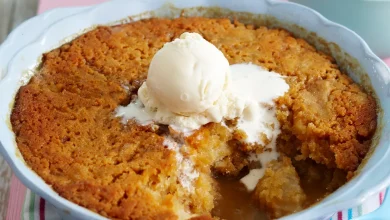Syrian Baklawa (Baklava) – A Sweet, Delicate Dessert
Prep Time: 1 hour
Cook Time: 1 hour
Total Time: 2 hours
Servings: Approximately 16-20 pieces (depending on size)
Recipe Category: Dessert
Keywords: Baklawa, Syrian Baklava, Middle Eastern Desserts, Nut Pastry, For Large Groups, Oven, < 4 Hours
Description
This Syrian version of Baklawa, a variation of the more commonly known Baklava, offers a slightly less syrupy take on the beloved dessert. Rich with walnuts and subtly infused with rose water, this pastry delivers an elegant combination of flaky, buttery layers with a sweet, aromatic filling. Unlike traditional Greek Baklava, the syrup here is more delicate, allowing the flavors of the nuts and butter to shine through without overwhelming sweetness. Whether you’re making it for a large gathering or a special occasion, this dessert will surely be a showstopper on any table.
While this recipe is typically made by my husband (since he’s the one with the patience to work with phyllo dough!), the steps are simple enough for anyone who enjoys baking. This version requires a bit of love and attention to detail, but the end result is well worth it.
Ingredients & Nutritional Information
| Ingredients | Quantity |
|---|---|
| Phyllo dough | 2 lbs (32 oz) |
| Butter (melted) | 3/4 cup (6 oz) |
| Walnuts (chopped) | 2 1/2 cups |
| Sugar (for nut filling) | 1 1/2 cups |
| Rose water (for nut filling) | 1/2 teaspoon |
| Sugar (for syrup) | 1 cup |
| Water (for syrup) | 1 cup |
| Lemon juice (for syrup) | 1 tablespoon |
| Rose water (for syrup) | 1 tablespoon |
Nutritional Information (per serving)
| Nutrient | Amount |
|---|---|
| Calories | 320.9 kcal |
| Fat | 24 g |
| Saturated Fat | 8.4 g |
| Cholesterol | 29.3 mg |
| Sodium | 166.6 mg |
| Carbohydrates | 25 g |
| Fiber | 1.6 g |
| Sugar | 13.5 g |
| Protein | 4.2 g |
Instructions
Step 1: Prepare the Baking Pan
- Start by thoroughly buttering your baking pan. You’ll need a 9×13-inch baking pan for this recipe. Ensure the pan is well greased to prevent the baklawa from sticking during baking.
Step 2: Lay the Phyllo Dough
- Place the first 1 lb (16 oz) of phyllo dough into the pan. Lay down the sheets one by one, brushing each sheet generously with melted butter. It’s important not to butter the top layer at this stage — just between the sheets.
- Be gentle when handling the phyllo dough, as it can tear easily. To prevent it from drying out, keep the unused phyllo sheets covered with a damp cloth or plastic wrap.
Step 3: Prepare the Nut Filling
- In a separate bowl, combine the chopped walnuts, sugar, and rose water. Mix well to ensure that the ingredients are evenly distributed.
- Spread this nut mixture evenly over the last layer of phyllo dough. Ensure an even distribution to avoid clumping in certain areas and to ensure the pastry has a consistent filling.
Step 4: Add More Phyllo Dough
- Place the second 1 lb (16 oz) of phyllo dough over the walnut mixture. Again, brush each layer with melted butter as you go. Repeat this process until all the phyllo sheets are used, remembering not to butter the topmost layer.
Step 5: Cut into Diamonds
- Using a sharp knife, cut the layered pastry into diamond shapes. This will make it easier to serve after baking, and it also allows the syrup to soak into each individual piece more effectively.
Step 6: Bake the Baklawa
- Preheat your oven to 400°F (200°C). Place the pan into the oven and bake for 15 minutes at this high temperature to get a crisp, golden color on top.
- After 15 minutes, reduce the temperature to 325°F (165°C) and continue baking for another 45 minutes. The baklawa should be a beautiful golden-brown color when finished.
Step 7: Prepare the Syrup
- While the baklawa is baking, prepare the syrup. In a small saucepan, combine 1 cup sugar and 1 cup water. Bring it to a boil over medium heat and let it simmer for about 15-20 minutes.
- Once the syrup thickens slightly, add the lemon juice and rose water, stirring well. Allow the syrup to boil for a few more minutes, then remove from heat.
- Let the syrup cool for at least 10 minutes before using.
Step 8: Pour Syrup Over the Baklawa
- Once the baklawa is done baking, remove it from the oven and let it cool for a few minutes. Then, pour the cooled syrup evenly over the hot baklawa. Allow the syrup to soak into the pastry layers, infusing them with sweetness and flavor.
Step 9: Let the Baklawa Set
- Allow the baklawa to cool to room temperature before serving. This will give it time to set and hold its shape. Once it has cooled, the baklawa is ready to be cut into individual diamond pieces.
Tips for Success
-
Phyllo Dough Handling: Phyllo dough can dry out quickly, so it’s important to keep it covered with a damp cloth or plastic wrap while working. This prevents the dough from becoming brittle and hard to work with.
-
Butter Application: Be generous with the butter between the layers of phyllo dough. The butter is what gives the baklawa its flaky, rich texture. However, avoid buttering the very top layer after the filling is added.
-
Let It Set: While it’s tempting to cut into the baklawa as soon as it’s done, letting it rest for a bit before slicing will help the syrup to soak in and give the pastry a chance to firm up.
-
Customizing the Filling: Though walnuts are traditional, you can experiment with other nuts like pistachios or almonds if desired. The choice of nut can alter the flavor profile slightly, but it will still be delicious.
-
Storage: Store any leftovers in an airtight container at room temperature. It should last for about 5-7 days. You can also refrigerate it to prolong freshness, though it may lose some of its crispness.
Conclusion
This Syrian Baklawa is an ideal dessert for any celebration or when you’re in the mood for something indulgent yet elegant. Its layers of flaky phyllo dough, rich buttery flavor, and the fragrant touch of rose water make it a treat that’s unlike any other. Whether you’re serving it at a large gathering or sharing it with loved ones, this baklawa is sure to impress. So, next time you’re craving something sweet with a Middle Eastern twist, give this recipe a try, and enjoy the delightful combination of textures and flavors that make it so beloved in the region.
Enjoy the sweet, delicate layers of this beautiful Syrian dessert, and don’t forget to serve it with a hot cup of tea for the perfect ending to any meal!



